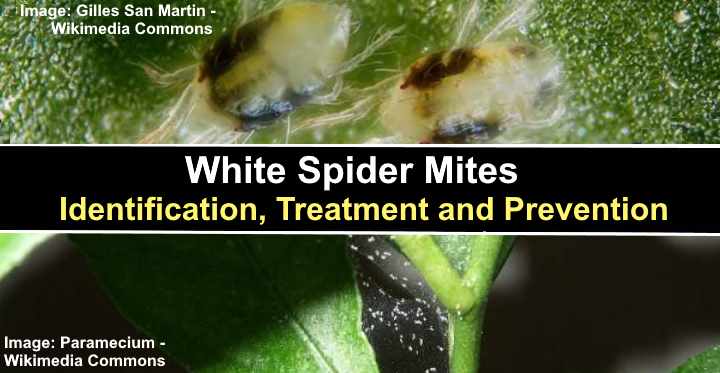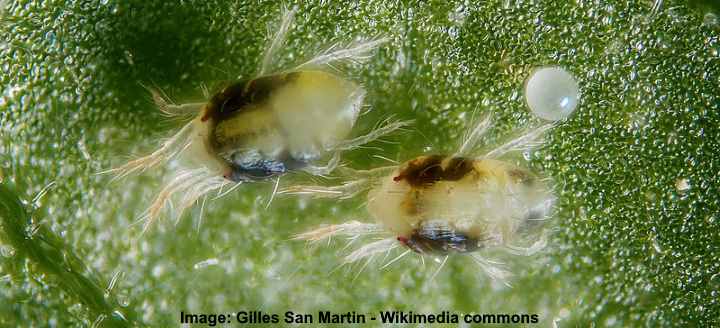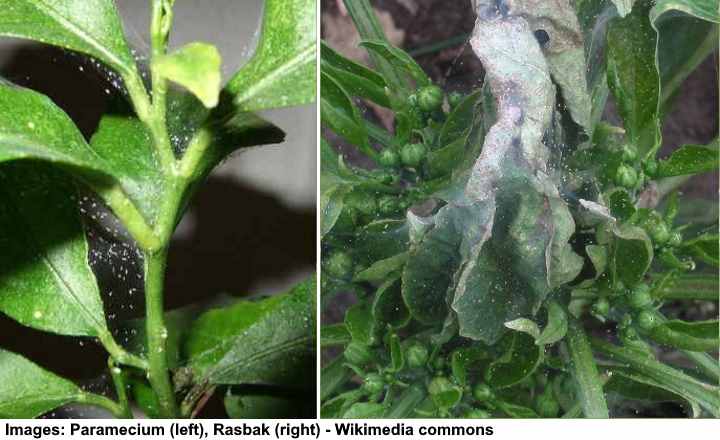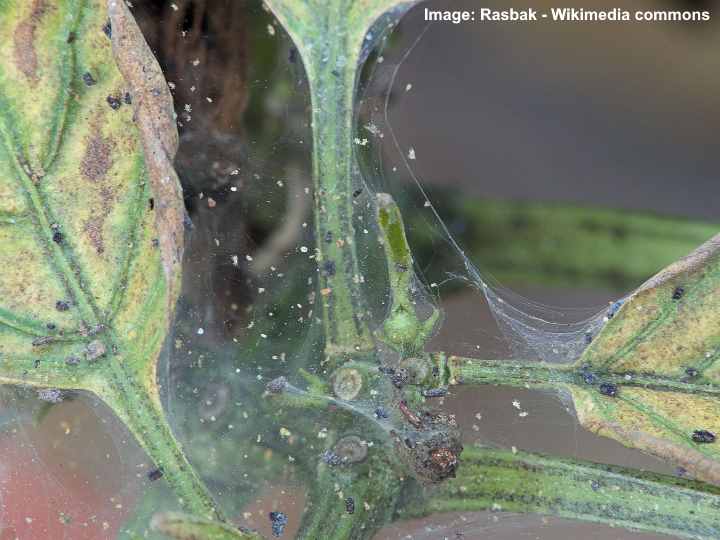White Mites: Identification, Treatment and Prevention of White Spider Mite Damage

White mites are tiny bugs that can infest houseplants and outdoor plants, causing foliage to wilt and turn yellow. Also called spider mites, these white arachnids are notoriously tricky to spot. The first sign of white mites on houseplants is typically strands of silky web dangling from leaves. A heavy white mite infestation typically is noticeable due to webbing between leaves and stems and masses of tiny white bugs underneath plant leaves.
White mites are almost impossible to spot with the naked eye. The pesky bugs may appear as minuscule light-colored dots, making them hard to identify. But up close, two-spotted white spider mites have translucent clear-white, oval bodies, tiny legs, and two antennae. Despite being tiny, white mites can do tremendous damage to your prized indoor plants.
This article is a complete guide to identifying white mites on houseplants. You will learn how to spot signs of white mites even though they are so minute. Additionally, you will learn about natural methods to kill white mites for good.
White Mites (Tetranychus urticae) Facts

Two-spotted spider mite females with spider mite egg
White mites are a species of two-spotted spider mites in the Arachnida genus Tetranychus. The plant-feeding mite is a pest on houseplants and outdoor plants. The issue with white mites is that the tiny clear white bugs are barely visible to the naked eye, making them challenging to identify before they become a nuisance.
White mites are not a species of insect. Instead, they are eight-legged arthropods, like spiders and ticks. These creatures range in color from translucent white to tan, dark green, and red.
White mites damage plants by sucking the juices from plant tissue. The tiny pests have piercing-sucking mouthparts, and white mites bite into leaves and stems with these. The result is leaf yellowing, and leaves may eventually turn brown. A severe white mite infestation can result in complete defoliation.
What Do White Spider Mites Look Like?
White mites have a whitish clear, pear-shaped body with a distinctive pair of dark spots to the rear of their body. The minuscule bugs measure 0.016” (0.4 mm) long, about the size of a grain of salt. Under a magnifying lens, you’ll notice the mites have eight spiny legs and a tiny head.
The easiest way to tell if you’re looking at a two-spotted spider mite is by looking for its characteristic spots. The name “two-spotted” refers to the dark spots on its translucent white back. Under a magnifying lens, you may see a dark stripe on the inside edge of its body.
Suppose you notice tiny red dots moving around or underneath houseplant leaves. In that case, the bugs may be a species of red spider mite.
White Mites Life Cycle
The life cycle of a white mite starts as a tiny white pearl-shaped egg. Next, microscopic larvae emerge, and they have six legs. Through the two nymphal stages, the mites grow another pair of legs. A white mite’s life cycle takes five to twenty days to complete.
An adult female white mite can live for up to four weeks, during which she can lay several hundred eggs.
During hot, dry conditions, white mites multiply rapidly. A female mite can start laying eggs in as little as 12 hours after becoming an adult. However, the number of eggs she lays depends on temperature, humidity, and type of plant.
How to Identify White Mites

White spider mite damage on a lemon plant (left). White mite damage on sweet pepper plant (right). You can also see the spider mite webs on the plant leaves
The way to identify white mites on plants is to look for webbing and plant damage evidence. White mites spin delicate silky webs, and you’ll often notice these dangling strands before spotting the mites. However, you’ll see larger webs covered in crawling white mites in a severe infestation.
White mite identification is also possible by observing plant damage. The tiny white-spotted mites bite into plant tissue and suck the juices. This results in discolored yellow or brown leaves. If you also notice strands of silk on leaves, you can be almost sure that your plant has white mites.
The best way to identify white mites is to use a 10x magnifying lens. Look closely under the leaves to look for white dots. A white mite has an identifiable tear-shaped body with two blackish spots on either side at its rear. You may also spot white round mite eggs stuck in leaf joints and the underside of leaves.
White Mite Plant Damage

This picture shows spider mite damage on sweet pepper plants – the spider mites are the tiny white bugs on the sticky webs
White mites damage plants by piercing leaves with their mouthparts and sucking out the liquid. Plant damage starts by looking like speckled or stippled patterns on leaves. The damage white mites inflict can then cause yellowing or browning of the leaves, leaf loss, and even plant death.
White mites tend to attack plants under stress. Therefore, it’s vital to avoid plant damage by ensuring plants are healthy by not overwatering or over-fertilizing them. Additionally, plants should receive sufficient sunlight and air circulation to help prevent white mite plant damage.
To help protect your plants from white mite damage, inspect plants regularly for signs of infestation. Then take swift steps to eradicate white mites from your houseplants before they do more damage.
White mites damage plants in another way. The tiny holes mites make on leaves also allow bacteria and fungi to infect the plants. This can lead to various types of foliar infections, making plants look sick and unsightly.
Where Do White Mites Come From?
White mites can come from anywhere. But the most common way they get onto your houseplants is by bringing newly-purchased infested plants into the home. Unfortunately, the tiny white bugs can also live in contaminated potting soil or on houseplants that spend summers outdoors.
Although bringing home contaminated plants is the most common way the tiny pests get into your house, there are other ways. For example, suppose you were at a local garden center, and they had infested plants. In that case, you may find that you unwittingly brought them home on your clothes.
White mites often infest outdoor plants or greenhouse crops during dry, hot summers. So, the pesky minuscule arachnids could hitch a ride indoors in your pet’s fur.
How to Get Rid of White Mites
Getting rid of white mites is a multi-method approach. White mite eradication starts with isolating the plant. Then it’s a good idea to use natural remedies to kill the tiny white bugs on plants. Some effective control solutions for white mites are a neem oil spray, insecticidal soap, and rubbing alcohol.
For several reasons, it’s best to avoid using chemicals to kill white mites. First, pesticides can contain potentially toxic chemicals. Additionally, white mites can build resistance to commercial pesticides, making them harder to eliminate. And finally, natural insecticides can be just as effective at getting rid of white mite infestations.
Let’s look in more detail at highly efficient and cost-effective ways to get rid of white mites for good.
Prune Affected Leaves to Get Rid of White Mites
The first step to getting rid of white mites naturally is to remove affected plant leaves and stems. Next, prune any stems and leaves that have silky webbing. Then destroy the cuttings or discard them in the garbage can outside. This way, you avoid infecting other houseplants or ornamental garden shrubs.
White mites can be as tiny as 1/50 of an inch (0.2 mm) long. So, they could be lurking anywhere on the houseplant. So, it’s vital to treat the rest of the plant with a natural white mite spray, regardless of whether the plant appears healthy or not.
Shower Plants to Remove White Mites
A simple way of removing white mites from houseplants is to rinse the leaves in the shower. All you need to do is put the plant in the bathtub and shower the leaves. This should be enough to force the destructive mites off your plant and down the drain.
Hosing shrubs, trees, and flowering ornamentals is also effective for eradicating white mites from outdoor plants. So, turn the hose on any bushes or trees showing signs of white spider mite damage. At the same time, you’ll also get rid of any other plant-destroying creatures from the plants.
Neem Oil to Kill White Mites
Spray the plants with neem oil mixed with a little Castile soap and water to kill white mites on houseplants. A natural neem oil spray contains azadirachtin — a natural pesticide that kills pests and stops them from reproducing.
It would be best to spray infested plants with the neem oil solution every seven days.
To make a neem oil spray, combine two teaspoons neem oil and one teaspoon of Castile soap with a quart (1 l) of water. Fill a spray bottle with the solution and shake well to mix the ingredients. Use the spray to cover both sides of the leaves and apply to all the leaves on an infected plant to kill the bugs for good.
Several scientific studies confirm the efficacy of using neem oil products to control two-spotted spider mites. For example, neem oil has a lethal effect on many mite species. In addition, the active ingredients in the natural substance have a repellent effect and disrupt a white mite’s lifecycle when used regularly.
Insecticidal Soap To Eradicate White Mites
A simple soap solution can have insecticidal properties when used to eliminate a white mite infestation. Combining vegetable oil with pure liquid soap and mixing it with water can help eliminate most houseplant pests without chemicals. In addition, you avoid risking spraying harmful chemicals in your home.
To make an insecticidal soap, combine one cup of vegetable oil with a tablespoon of liquid Castile soap to make a base mixture. To rid houseplants of white mite activity, dilute one quart (1 l) of warm water with two teaspoons of the base mixture. Then, spray liberally on foliage to kill plant pests.
You can also dip a clean cloth in the soapy solution to wipe down infected plant leaves. The soap and oil coats the bodies of bugs, tiny arachnids, insects, and mites. This has a suffocating effect, and the fatty acids break down the mites’ bodies, causing them to die.
Use Diatomaceous Earth to Control White Mites
Diatomaceous earth (DE) is a natural pesticide powder that can be useful for eradicating spider mites. DE is lethal to spider mites because its abrasive nature destroys the arachnids by causing their bodies to dehydrate. The good news is that diatomaceous earth is safe to use in the home and around pets.
To use diatomaceous earth to kill white mites, use food-grade DE. First, put on a protective mask to avoid breathing it in. Then sprinkle the white powder on leaves and dry plant soil. You may have to use a brush to apply the powder to the undersides of leaves. Reapply every few days for the best results.
It’s vital to remember that DE loses its effectiveness when it gets damp. So if you’re using diatomaceous earth as a pesticide or miticide for outdoor plants, only apply it during dry weather and reapply after it’s rained.
Vinegar Spray to Kill White Mites
Kill white mites quickly with a vinegar spray. To make a mite control spray, combine 1/4 cup of vinegar with a quart (1 l) of water. Then add a tablespoon of baking soda and a few drops of natural dish soap. Shake well. Spray over all plant foliage to eradicate spider mites.
Rosemary Oil Spray to Eradicate White Mites
Eliminate white mites with a natural spray using essential oils with miticidal activity. For example, some studies suggest that rosemary oil effectively eliminates two-spotted spider mites from certain crops. In addition, the natural spray is non-toxic for humans and pets and doesn’t affect crop plants.
To make a natural spray for white mites, mix one teaspoon of high-quality rosemary oil with a quart (1 l) of water. Use the spray to coat both sides of infected plant leaves. Use once a week for best results. If the mite treatment seems ineffective, try increasing the rosemary oil concentration.
Rubbing Alcohol to Kill White Mites on Contact
Rubbing alcohol is an effective remedy for controlling white mites on plants. Make an insecticide spray by mixing one part rubbing alcohol with one part water. Spray on plants wherever you notice white mites or signs of webbing. Use it every few days until all signs of white mite activity have gone.
Alternatively, put 70% isopropyl on a clean cloth and wipe infected leaves. Rubbing alcohol can kill plant pests on contact. Please remember to test a small leaf area to ensure the alcohol isn’t too strong for the plants.
How to Prevent White Mites
It is vital to take preventative measures to stop tiny, crawling, plant-eating white mites from destroying your houseplants. Ensuring optimal plant health is crucial in avoiding the common nuisance. However, there are other steps you can take to prevent white mite infestations.
Keep humidity high to prevent white mites
White mites tend to thrive in dry environments and arid soil. Therefore, ensuring tropical houseplants and other indoor plants have adequate humidity is vital to avoid spider mite problems. Use a room humidifier or keep houseplants on a pebble and water tray to keep spider mites away.
It is also vital to have proper watering techniques to keep houseplants healthy. Overwatering or underwatering plants can invite nasty pests like mites and gnats. Therefore, as a rule, only water houseplants whenever the top 1” to 2” (2.5 – 5 cm) of soil is dry. Then saturate the potting soil and allow excess water to drip out the drainage holes.
Check new plants for white mite webbing
Avoid bringing bugs into your home by checking new plants for white mite activity. In the garden center or plant shop, inspect plants for silky webs, yellow or brown patches on leaves, or tiny white, green, or red dots under leaves.
Generally, it’s a good idea to quarantine any new plant for two weeks when you bring one home. This is not only to check for white mites. But you can ensure there are no other pest infestations like aphids, mealybugs, thrips, scale insects, or fungus gnats.
Similarly, houseplants kept outdoors in the summer can get all sorts of pests on them. Therefore, put them into isolation for a couple of weeks before putting them beside other houseplants.
Wipe plant leaves regularly to prevent white mite infestations
Wipe your houseplants weekly to reduce the occurrence of white mites and other plant-destroying bugs. There are three reasons why wiping houseplant foliage is a good idea.
First, wiping leaves with a damp cloth removes tiny mites and other pests before they have a chance to do any damage. Second, wiping tropical houseplant leaves adds moisture and keeps plants healthy. Third, wiping leaves removes dust and keeps them looking healthy.
Learn How to Get Rid of White Bugs on Plants.
Related articles:
- Effective Ways to Kill Aphids on Plants
- Effective Ways to Kill Mealybugs on Plants
- How to Kill Scale Bugs (Scale Insects)
